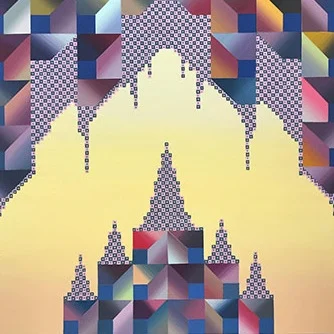Studio Visit | June Ahrens
Studio Visit | June Ahrens
June Ahrens’ studio in Stamford, CT, July 2019. Photo: J. Gleisner.
Large sheets of reflective Mylar covered the floor of June Ahrens’ studio, casting thin, white ribbons around the walls. As the afternoon light shifted in the space, the reflections began to resemble the shimmering surface of a pool or lake with ripples of water, yielding a predictable sense of calm. Suspended from the ceiling were over two hundred wire and rope strands interspersed with knotted bundles representing flowers and thorns in a “symbolic garden.” Some were loose and sprawling, while others seemed tightly bound like a nest. These elements comprised a mock-up of Ahrens’ upcoming installation How Many Tears Are Enough? at the University of Connecticut’s Stamford Gallery, opening this October.
Ahrens views this piece as a response to the gun violence in this country. There are no guns and no other obvious symbols that connect the work to this issue. Rather, Ahrens wanted to use her own vocabulary to respond to these events. “This work is about remembering and honoring,” she explained. Her studio has a somber aura.
Ahrens’ process is intuitive and additive, a slow response to deep wounds. She began constructing the individual strands about a year and a half ago, around the time of the Parkland school massacre. One of Ahrens’ former studio assistants had graduated from Marjory Stoneman Douglas High School in Florida. Yet another assistant is married to a teacher who had worked at Sandy Hook Elementary School in Newtown, CT. She described feeling surrounded by these tragedies. Overcome by a profound sense of powerlessness, Ahrens wondered how anyone could stop the unimaginable cascades of loss.
This recent work is not the first one of Ahrens’ to respond to trauma. On the morning of September 11, 2001, Ahrens was at home, nine blocks from the site of the World Trade Center Buildings. Ahrens, who had returned from vacation the day before, described looking out one of her windows that morning and seeing people running through the streets, hysterical with fear. Her husband, who was away on a business trip, had called to check in, but it wasn’t clear what she should do or where she should go. Beyond the tragic outline of the morning’s events, there was so much confusion.
That morning, Ahrens joined a nanny, a mother, and four children—all from her building—on a slow trek to seek shelter in a safer part of the city. Public transportation and car traffic had almost entirely stopped, so together they relied on the kindness of strangers and each other as they walked uptown. Ahrens recalled stopping at a store to purchase paper towels, which they dampened and used to shield their faces from the debris and smoke. “It was the first time in my life that I felt that I was singularly alone,” Ahrens said.
As a response to the events of that day, Ahrens initiated a collaboration called The Healing Hearts Project. The instructions were simple: make a heart the size and your hand and put a message inside it. From all around the country, participants sent her their fabric hearts with their wishes embedded inside.
These sentiments were never read or shared; the idea was to offer people a way to grieve privately. The hearts installed in groups inside large circles on the grass at many locations around the country including Battery Park in New York City and Cove Island Park in Stamford, CT. Some of these hearts were later given away. A few were placed inside the site of the memorial at ground zero.
June Ahrens, The Healing Hearts Project. Battery Park City, New York, NY.
The Healing Hearts Project was not an illustration of the pain caused by the September 11th attacks, but a shared catharsis. Ahrens received over 1,500 hearts from around the world. As with How Many Tears, she chose to use symbols instead of direct commentary on the events. Both works offer viewers an opportunity to grieve as a group instead of experiencing the pain individually.
For Ahrens, this call for togetherness is what motivates her practice as a visual artist. Her work attempts to hold on to the memories of the victims of these disasters and make space for mourning and healing for those left behind. The Healing Hearts Project began as a response to the terrorist attacks on September 11th, but it was revived last year in the wake of the Parkland shooting. With Ahrens’ permission, former studio assistant Nicoelle Cohen issued a call on social media. The gathered hearts were then shared around different sites in Parkland.
All of Ahrens’ quotes are from a conversation with the author at Ahrens’ studio in Stamford, Connecticut on July 22, 2019.





